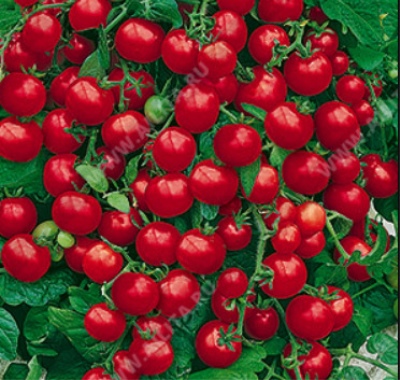
- Authors: N.V. Nastenko, V.G. Kachainik, A.V. Kandoba (Agrofirma "Aelita" LLC)
- Year of approval: 2010
- Category: grade
- Growth type: determinant
- Appointment: fresh consumption, for whole fruit preservation
- Ripening period: early
- Ripening time, days: 90-95
- Growing conditions: for open ground, for film greenhouses, pot culture
- Bush size: undersized
- Bush height, cm: 50
Not everyone likes huge tomatoes. It is these people who will like the small and neat Pugovka tomatoes. This is a very famous early maturing variety related to ornamental. It can even be planted in a pot and placed on a windowsill, balcony or loggia, in a winter garden. Of course, it can also be grown in an open garden or in a greenhouse.
Breeding history
The variety was bred in the agrofirm "Aelita" with the participation of such well-known experts in the field of tomato breeding as Nastenko, Kachainik and Kandoba. In 2010, the crop was included in the lists of Rosreestr in the Russian Federation and recommended for cultivation both in open ground and under film shelters on the territory of personal subsidiary farms.
Description of the variety
A button is a standard determinant type of tomato with small elongated leaves painted in a dark green color scheme. The culture is distinguished by intermediate inflorescences, and the fruit stalks have articulations.
Compact strong bushes can have a height of up to half a meter, sometimes there are also higher specimens, reaching 65 cm. Due to the low height, it is not necessary to tie the trunk to a support.
The plant has many stepsons, fruit-bearing ovaries are formed on them. On the brushes, 12-15 small fruits with a diameter of 1.5-3 cm grow. It should be borne in mind that tomatoes do not ripen in a brush at the same time. Each stem of the Button can contain from 3 to 4 such brushes.
The main qualities of the fruit
Button tomatoes are small, smooth. Rounded shape. The density is medium. Unripe fruits are colored light green, with the same speck at the base. Fully ripe tomatoes have a bright red color, which makes the plant so decorative. Since the culture belongs to the group of cherry tomatoes, the weight of each fruit reaches from 10 to 15 grams, but there are also more weighty tomatoes, up to 25 grams. Inside there are 2-3 seed chambers. Tomato peel is dense, so it can withstand long-distance transportation and long-term storage up to 14 days.
Taste characteristics
They note the excellent taste of Pugovka tomatoes, their sweetness and aroma. Small, beautiful fruits are ideal for canning whole fruits, as well as for fresh consumption, in salads. They can be used as a dietary product for children and adults. Perfectly decorate any meat, fish and poultry dishes.
Ripening and fruiting
The Pugovka variety is early ripening, the growing season lasts no more than 90 days. Fruit ripening can be observed in July-August.
Yield
The crop is fruitful. Marketable fruits from 1 m2 in film shelters are obtained in an amount of 4-4.5 kilograms.
The timing of planting seedlings and planting in the ground
Button seedlings can be planted from March 20 to April 10. Accordingly, the resulting seedlings move into the ground from May 15 to June 5.

Growing tomato seedlings is an extremely important process, because it largely depends on whether the gardener will be able to harvest at all. All aspects must be taken into account, from seedbed preparation to planting in the ground.
Landing scheme
The usual scheme for the arrangement of tomato bushes Button - 50x40 cm.

Growing and care
When growing a determinant tomato, the Button usually does not require pinching - the shoots from the sides will stop growing after the formation of two leaves and one flower brush. Removing tomatoes is best done after they are fully ripe. It is noted that fruits that have ripened at home have worse palatability compared to those ripened on the bush.




A plant needs different micronutrients at each stage of growth. All fertilizers can be divided into two groups: mineral and organic. Folk remedies are often used: iodine, yeast, bird droppings, eggshells.
It is important to observe the rate and period of feeding. This also applies to folk remedies and organic fertilizers.
Disease and pest resistance
The Pugovka variety is resistant to such ailments as verticillosis, fusarium wilting. And also not prone to cracking of the fruit.


Growing regions
The culture is zoned for almost the entire territory of the country. It can be grown in the North, North-West, Central, Volgo-Vyatka, Central Black Earth, North Caucasian, Middle Volga, Lower Volga, Ural, West Siberian, East Siberian, Far Eastern regions.

























































































